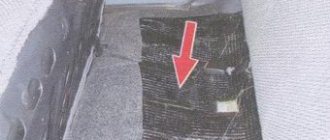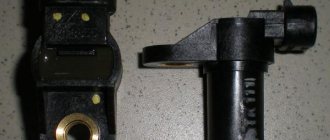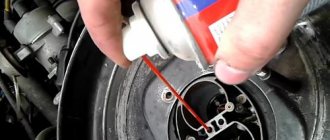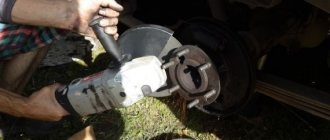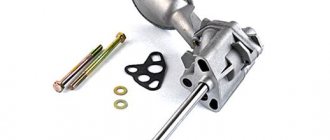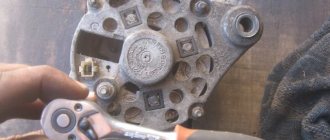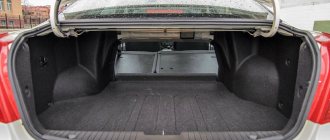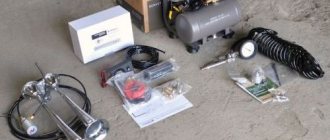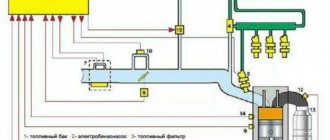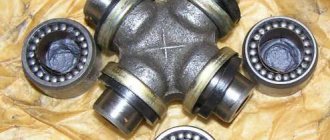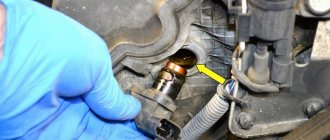Pros of switching to an injector
There are quite a lot of positive aspects when switching from a carburetor to an injector. The main reasons are the following:
- Saves fuel by supplying it directly to the engine cylinder.
- Engine power increases, especially at low speeds.
- Increases stability at idle speed.
- Carbon dioxide emissions into the atmosphere are reduced by using 90% of the total potential of the fuel mixture.
The injection system is considered more modern and environmentally friendly. It ensures compliance with Euro-2 standards, which a carburetor engine cannot boast of. Due to the presence of a special controller, even when running cold, the car will start easily and operate stably.
It is worth noting that the injector also has its drawbacks. Among them:
- demands for good fuel;
- more complex diagnostics and maintenance;
- high cost of repairs.
The device of a simple injector
The simplest car injector includes:
- Sensors;
- Electric fuel pump;
- Controller (ECU);
- Pressure regulator;
- The actual injector (nozzle).
Sensors are needed to measure parameters such as:
- Air mass;
- Throttle position;
- Air temperature;
- Fuel consumption;
- Crankshaft position.
The ECU is the brain of the fuel injection system. It controls the injectors according to a certain algorithm, processes signals from sensors, and makes the necessary calculations.
Injection engine
The electric fuel pump forces gasoline to the pressure regulator, which maintains constant pressure in the system.
The injector is a solenoid valve that is activated when control voltage is supplied from the ECU. The opening moment of the injector determines the amount of fuel and air supplied to the combustion chamber. The fuel assembly supply channel of the injector is designed in such a way as to ensure effective atomization and distribution of the mixture in the cylinder.
Carburetor vs injector
An injector malfunction is much more difficult to resolve than a carburetor malfunction. You need to connect to the controller, and for this you have a special program. Otherwise, you will have to contact a car service, and you have to pay for it. The injector has more parts distributed under the hood. Moreover, the quality of the fuel also plays a big role. A large number of sensors requires a lot of wiring. The injectors sometimes become clogged, or the electromagnet winding burns out. Interference and interference affecting the wiring distorts the signals, so the location of its installation plays an important role.
Undoubtedly, the injector accurately doses the mixture into the combustion chambers and prepares it with the required composition. Fuel economy in this case is natural. In addition, in winter the car starts better; idle speed does not need to be adjusted frequently. The car becomes more responsive and powerful.
The carburetor can be repaired almost on the knee. It is easy to remove, disassemble and assemble. If there is no source of compressed air nearby, you can blow it out with your mouth using a tube. Adjusting it will not be difficult if you have the appropriate knowledge.
It's up to you to install an injector or leave a carburetor!
What to prepare to change
The whole process will take you about a week, provided you work 3-4 hours a day. Therefore, prepare your garage in advance and buy everything you need. You can assemble the injector on different ECU controllers, but in the case of the VAZ-2109, the January 5.1.1-71 model is better than others. Available domestic spare parts can be used for it, and it does not use an adsorber and an oxygen sensor.
Advice: It is better to buy all components in a good store with experienced staff, as you may need help in choosing the right spare parts. If you have experience in repairs and want to save money, then shop at a disassembly store.
Features of the injector, list of equipment for replacement
Before installing the injector yourself, you should first of all turn to theory. The vast majority of VAZ 2106 cars (modifications 21060, 21061, 21064, 21065) were equipped with carburetor naturally-aspirated engines of 1.45 and 1.6 liters with the same cylinder head (cylinder head) - 2101.
This cylinder head is not suitable for installing an injector on it, since it has inlet holes of inappropriate shape and does not have studs for attaching the intake manifold to the receiver. Of course, you can remake it for cost-saving reasons, but if you do not have special knowledge, then it is better to purchase a ready-made cylinder head assembly from the modernized Niva - 21214.
The Niva's engine is not much different from the 2106 engine, so its cylinder head is ideally suited to the design characteristics.
In case of financial problems, you can purchase an empty cylinder head and replace the valves and other things from the old head into it. But again, this requires knowledge and experience. In addition to the cylinder head, you will need to purchase the following equipment from the VAZ 21214.
- The ramp is assembled with nozzles and pressure regulator.
- The receiver is complete with a throttle assembly and idle air control.
- Intake manifold.
- Gasket for intake and exhaust manifolds.
- Receiver gasket.
- Front engine cover with a hole for the crankshaft position sensor (CPS).
- Crankshaft pulley with space for DPKV.
- DPKV.
- Throttle position sensor (TPS).
- Instant air flow sensor (MAF).
- Antifreeze temperature sensor.
- Speed sensor.
- Knock sensor (DS).
- Accelerator pedal with drive cable.
In addition to the above spare parts, you will also need to purchase:
- Engine control unit (controller) January 7.2.
- Wiring for the control unit (braid from the injection VAZ 2107).
- Ignition module with bracket.
- High voltage wires.
- Electric fuel pump from Volga or Daewoo Damas.
- Fuel hoses and filter (injection).
- Electric radiator fan (only if there was none before).
- Plugs for the mounting location of the distributor and mechanical fuel pump.
Tools
The repair will consist not only of dismantling some components and mechanisms. In some cases, it will be necessary to make changes to the design of cylinders and other parts.
From the tool you will need:
- Set of wrenches.
- Flathead and Phillips screwdrivers.
- Good drill.
- Hammer and chisel.
- Rust remover.
Preparing for installation
After purchasing all the necessary spare parts, you can begin upgrading. First you need to dismantle unnecessary equipment, in particular:
- loosen and remove the generator belt;
- remove the crankshaft pulley and camshaft drive cover;
- dismantle the distributor, fuel pump and switch;
- remove the carburetor and air filter;
- dismantle the old cylinder head along with the manifolds;
- unscrew the exhaust manifold and coolant distributor tee from the cylinder head (located in front of the manifolds in the direction of travel of the car);
- dismantle the accelerator drive rods, the gas pedal and unnecessary wires (to the coolant sensor, ECXX, distributor);
- remove the gas tank (if it will be replaced).
Next, preparatory activities should be carried out.
- Drill a hole on the ebb of the coolant distributor tee, screw a new antifreeze temperature sensor into it and install the tee on the new cylinder head.
- Secure the TPS in its proper place in the throttle valve assembly.
- Close the holes in the block left after removing the mechanical fuel pump and distributor with plugs.
- Extend the return line to the fuel tank, if there is none.
- Attach the electric fuel pump mounting bracket in the trunk or under the bottom and embed the fuel pump into the fuel supply hose.
Installation of the injection system
After completing the preparation, you can begin installing the injector.
- First you need to install the cylinder head from the VAZ 21214 on the cylinder block.
- Then you need to install a new front block cover, a new crankshaft pulley and secure the DPKV.
- Place the gasket on the cylinder head intake and exhaust ports and screw the new intake and old exhaust manifolds into place.
- Place the spacer over the triangular mounting area where the 2 studs are located and a simple spacer over the manifold inlet ports.
- Insert the fuel rail with injectors into the exhaust pipes and secure it with 2 screws.
- Screw the receiver assembly with throttles and idle air control into its proper place.
- Secure the DD to the screw securing the distributor plug.
- Hook the speed sensor onto the speedometer drive gearbox.
- Attach the ignition module to the engine shield next to the brake reservoir.
- Secure the gas pedal to the right studs of the VUT.
- Attach the gas cable with one end to the pedal, the other end to the throttle assembly and secure it to the receiver bracket so that it sags slightly.
- Finally, you need to attach the fuel supply hose and the return hose to the injector.
After this, all that remains is to install the control unit, connect sensors and the rest of the machine’s wiring to it according to the presented diagram. The average cost of installing an injection is about 20,000 rubles, but it is reduced several times when using used spare parts.
Work process
To do this, you will need a drill, a small amount of anti-corrosion agent and a set of screwdrivers.
The first step is to buy elements that do not often fall into disrepair on a car: intake manifold, fuel tank, receiver, fuel line, and more. After this, you need to disassemble the old tank and install a new one, having previously secured an electric pump there. It is imperative to apply a corrosion inhibitor to the surface of the fuel tank.
You will have to make several holes on the cylinder block, which will be needed to fix the ignition module holder and knock sensor. Drilling must be done carefully so as not to make a through hole, since in this situation the cylinder block will be damaged. To install the knock sensor, you will need to make a hole to a depth of only 16 millimeters, and to fix the holder - 20 millimeters.
It is worth noting that to begin the work process, you must drain any liquids, remove the radiator and front bumper. The knock controller has a tapered thread, which means it needs to be screwed in all the way. After this, it is necessary to replace the pipe for discharging the cooling solution. If a temperature sensor is installed on the cylinder block, it will have to be replaced with a plug, and if it is not, then a plug will still need to be installed.
The most difficult process in this matter, perhaps, will be laying the fuel line, which is carried out along the underside of the underbody. It is recommended to do this with an assistant, especially when pushing the return line from the bottom of the steering mechanisms.
Upon completion of all assembly work, connecting wiring and hoses, as in the case of replacing a carburetor with an injector, it is necessary to test the engine at idle speed, check its sealing, ignition and smooth operation.
What engines can be installed on the VAZ “classic”
The VAZ 2107 is certainly considered a classic of the domestic automotive industry. Therefore, the same rules apply for this model as for the entire “classic” AvtoVAZ line.
Two engines can be considered the best options for the “seven”:
These 16-valve engines have virtually identical mountings and require very little modification for installation. In addition (which is also important), the current gearbox from the VAZ 2107 is quite suitable for these engines, thereby saving the driver time on installing the gearbox.
Read this, it might come in handy: Why does the engine overheat?
And it is advisable to purchase such an engine already used, which will significantly save the existing budget. However, a used motor should be purchased from friends or from a seller who can provide a guarantee for his product.
Sixteen valve engine
Such engines are typical for more modern versions of VAZ - for example, Priora or Kalina. The design of the 16-valve power unit is more complex than that of the 8-valve due to the presence of two camshafts oriented in different directions. Accordingly, the number of valves on the cylinders doubles.
Thanks to this arrangement, each cylinder has two valves for injection and two valves for gas outlet. This gives the car higher power and reduced noise during combustion of the air-fuel mixture.
All the advantages of a 16-valve engine
Installing a more powerful 16-valve engine on the “seven” provides the following advantages:
- Increased power of the power unit both in normal driving modes and during acceleration and overtaking.
- Reduced noise effects when driving (this is achieved by installing a rubber belt together with the timing chain).
- Reliable operation - more modern motors have an increased service life and a more thoughtful design.
- Environmentally friendly emissions (two lambda probes are installed in the catalyst).
Installation Disadvantages
However, with all the advantages of replacing an 8-valve engine with a 16-valve engine, there are also disadvantages. Traditionally, drivers talk about three disadvantages of such an installation:
- The need to transform several vehicle systems: brakes, electrical equipment, ignition, clutch.
- The high cost of the new 16-valve engine.
- Reworking the mounts to suit the needs of the new engine.
Thus, installing a 16-valve engine on a VAZ 2107 is not considered a simple procedure. Not only experience and special knowledge will be required, but also the correct organization of the entire work process, in which the choice of a suitable power unit is not the least important.
Electrical refurbishment
For high-quality operation of the new power unit, you will have to replace the gasoline pump. You can take this mechanism from both the Priora and the Twelfth, or you can save money and buy a pump from the injection model of the Seven. The fuel pump is connected according to the usual algorithm and does not require any modifications.
On the VAZ 2107, the motor is connected with only three wires. The new engine requires a qualitatively different connection. First of all, you will need to complete the following steps:
- Install the engine control unit (for example, from the VAZ 2112 model).
- Connect all the sensors included in the kit to it - the wires should be pulled along the same places where they are stretched on the VAZ 2107 (in some cases, the standard wiring will need to be extended).
It is recommended to carry out all connections and new formations on the VAZ 2107 in the same way as they were done on the VAZ 2107 with an injection engine.
Read, it may come in handy: Installing a VAZ-2107 radio: how to connect correctly
Brake system
The new motor has higher power characteristics, which means that the car will accelerate faster and brake slower. In this regard, it is recommended to modify the braking system on the VAZ 2107. To do this, it is enough to replace the main cylinder with a more powerful one, and also, if necessary, replace all the cylinders if they are badly worn.
Cooling system
As a rule, the available potential of the standard cooling system on the “seven” is enough to promptly cool the new powerful engine. However, if the engine lacks cooling, a slight modification will be required: fill the expansion tank not with antifreeze, but with a higher quality antifreeze.
Thus, installing a 16-valve engine on a VAZ 2107 is a complex procedure, as it requires not only significant physical effort, but also thoughtful action. The main difficulty of this operation is connecting the wiring and modifying the system.
Sources
- https://FB.ru/article/183143/ustanovka–klapannogo-dvigatelya-na-klassiku-preimuschestva-i-nedostatki
- https://avto-lover.ru/novosti/vaz-2107-na-16-klapannom-motore.html
- https://avtika.ru/shema-ustanovki-16-klapannogo-dvigatelya-na-klassiku/
[collapse]
Replacing the carburetor with an injector
Now let's look at a more popular and frequent option for upgrading the engine power system, namely installing an injector on a carburetor power unit. In short, to solve the problem you need to replace the intake manifold, receiver, install an air filter housing, change the fuel line, install another gas tank with an electric fuel pump, mount an ECU, etc.
As an example, let's take the replacement for the VAZ model, which was produced in different configurations with a carburetor and injector (2108, 2109, etc.). As a rule, used spare parts are used for such alterations. At the heart of the electronic injection system, many use the Bosh M1.5.4 control unit.
This type of ECU is relatively easy to flash; there are many upgraded firmware versions available for it. The catalyst and lambda probe (oxygen sensor) are also excluded from the general scheme.
- So, work begins with replacing the fuel tank. If the tank is dirty, then it must be rinsed first. After this, the electric fuel pump is installed. Let us add that in some cases it is possible to insert the pump into the fuel line without replacing the tank itself.
- Next, you need to drill an additional mounting hole in the BC for the knock sensor (knock sensor). There are also holes for mounting the bracket. The bracket is needed to install the ignition module.
Note that on some motors the holes may already be drilled at the factory. If there are no such holes, then you need to look for special low tides on the BC. The hole depth for the knock sensor is 1.6 cm, for the bracket 2 cm. Drilling must be done carefully so as not to damage the block. Also, after drilling, it is necessary to cut the internal thread.
- To gain access to the unit, you will need to remove the front bumper, drain the antifreeze, remove the cooling radiator, etc. You also need to take into account that the coolant outlet pipe will need to be replaced with a similar one, but with a temperature sensor.
Some also change the thermostat using a tee from the VAZ 10th model, which allows you to connect the expansion tank. At the same time, you will need to replace the gasket, since the old one is usually destroyed or damaged after removing the outlet pipe.
- The next step will be to work with the internal combustion engine itself. First you need to drain the engine oil, remove the timing belt and toothed pulley, and remove the engine sump. As for gaskets, you should strive to preserve the ones you already have, since it can be difficult to purchase new ones of good quality.
Further improvements to the engine include replacing the oil pump of the lubrication system. You also need to replace the standard generator pulley with a damping one. At the same time, the generator is also being changed, for which fastenings are prepared separately. The alternator belt is replaced with a V-type belt.
- Now you can move on to the ignition, power and electronic control systems. You will need to remove the battery, distributor, fuel pump, air filter housing, carburetor, manifold and other elements.
You also need to remove the throttle cable, since on versions with an injector this cable is longer. The choke cable, the ignition system wiring under the hood, the coil and switch, and the idle control system are also removed. Replacement work will also require removing the fuel pipes and the vacuum booster hose, which also needs to be replaced with a longer hose (suitable from a VAZ classic).
- A sufficient number of manipulations will require connecting various elements of the ECM, ignition, sensors, etc. In other words, electrical work begins, for which you need to disassemble the instrument panel.
Among the main operations, the need to lay out the wiring harness from the ignition switch and implement the tachometer input should be highlighted. Connecting the check light bulb will also require laying a separate wire. The wiring from the engine compartment must be pushed into the cabin, after which the connection is made. You also need to connect the injection system wiring to the mounting block.
You will also need wiring to connect the dashboard with the wires to the fuel pump. This is necessary for the correct operation of the fuel level indicator in the tank. The standard wires running along the floor to the tank are replaced with new ones, and there must be a special connector for connecting the pump.
Additionally, you need to make sure that the cooling system fan is working properly. To do this, you need to short-circuit the wires that go from the fan to the sensor that turns it on. Next, the controller, fuses and relays are mounted in those places where their placement was previously provided. Upon completion, a so-called plug is mounted on the cylinder head, to which the “ground” of the injection system is connected.
- Now you can install the manifold, install the fuel rail with injection nozzles, install the receiver and throttle pipe. Also at this stage the throttle cable is replaced.
Then the fuel line is laid along the bottom of the car. The most difficult part is often the passage of the “return”, which must be carried out under the steering mechanism. To solve the problem, you need to release the steering rack fasteners on one side, and then ask an assistant to press the mechanism with a crowbar or pry bar.
- The final stage of work with the internal combustion engine power system can be considered the final installation of the fuel tank. If everything is in order, you should connect the fuel lines. Maintain reliable fixation of all elements using clamps and fasteners.
Now you can activate the fuel pump (supply power to it) and create pressure in the fuel system. This is necessary to check the tightness, and such diagnostics must be done before the injectors are installed in their injector holes. If the check of the injectors and all pressure connections is successful (no fuel is leaking anywhere), then the fuel rail can be attached to the manifold.
- Next, you will need to install the necessary ECM sensors, mount the ignition module, and install the spark plug wires. Separately, you should check the reliability of the “ground” fastening, the quality of the wiring, the tightness of the connections of hoses and pipes.
The completion of the entire process of modifications can be considered the installation of an air filter, as well as the connection of the heating of the throttle pipe and the crankcase ventilation hoses of the internal combustion engine. Now the engine can be started, after which it may be necessary to adjust the quality of the fuel-air mixture in idle mode, etc. It is best to entrust such work to those who specialize in ECU chip tuning.
Why change a carburetor engine to an injection engine, and is it necessary?
Some drivers ask: why is it necessary to replace a carburetor engine with an injection one? Basically, everyone does this to install 4th generation gas equipment, and 2-3rd generation gas installations will work much better than on a carburetor.
This is due to the fact that the injection will no longer go through two chokes, but through one. You can leave everything on the carburetor brains, but then you will have to forget about gasoline, because standard injectors will not work if the control unit is carburetor.
Another positive point is that in the design of the intake manifold, in any throttle position, both intake valves operate. There is also a difference in fuel consumption. But the consumption itself mainly depends on the car, gearbox, axle, etc. And the mandatory use of high-grade fuel in an injection engine will not save you money. The car starts up much better after the changes, in any frost.
Important! For normal operation of the injector, it is necessary to flush the system every 25 thousand kilometers.
Pros and cons of the injector.
The injector provides fuel injection either into the air stream or into the combustion chamber.
Numerous sensors monitor air flow, engine speed, knock and crankshaft position. The control unit processes data from sensors and controls the injectors, ensuring the right amount of fuel is supplied at the right time. The injector provides better mixing of air and fuel compared to a carburetor. Therefore, the power increases slightly.
Injection engines are more complex, but the composition of the air-fuel mixture better suits any operating mode.
How to install an injector on a VAZ 2106
Installing an injector on a VAZ is accompanied, first of all, by purchasing the necessary parts. There are special kits for sale for the VAZ 2106. You just buy and install. A description of the installation process is usually included in the kit. This installation is the simplest option for the VAZ 2106. However, buying the entire kit will be quite expensive. In this case, of course, you won’t have to rack your brains over what, how and where to put it.
Preparation
Installation of the injector is carried out after preparing the VAZ 2106:
- Removing the carburetor;
- Remove the carburetor wires;
- Ignition coil;
- Switch (if any);
- Drain the coolant;
- Disconnect the intake and exhaust manifold;
- We change the forced cooling of the radiator to electric;
- We change the gas tank to another with an electric fuel pump;
- Remove the distributor and fuel pump;
- We install the plugs in their place.
Before you buy all the equipment, you need to decide which controller will be installed on the car. Depending on this, we purchase everything else.
Equipment installation
Installing a crankshaft position sensor (CPS) requires replacing the VAZ 2106 engine cover with a new one with a shimmer. To do this, you will first need to remove the crankshaft pulley. When a new cover is installed, all the sealing parts are changed. The engine head will need to be bored out or replaced with a new one from the injection Niva, since the carburetor has smaller inlet ports than the injection one. In addition, it will be necessary to provide for mounting the receiver.
Next, we fix the receiver, the ramp with injectors, and the exhaust manifold. Don't forget about gaskets between connections. We screw the throttle assembly to the receiver. You also need to install an ignition module and a knock sensor (DS). On some engine models, installing the latter can be difficult because it needs to be positioned as close to the cylinders as possible.
A fuel filter must be inserted into the rupture of the supply tube. We select it from those available for sale. It all depends on your preference.
The speed sensor is located between the gearbox and the speedometer cable input. It will be most convenient to extend the pipe for reverse drainage of fuel along the bottom of the VAZ 2106 car.
Unclaimed projects
The experimental design production of the car plant, in collaboration with developers, worked on promising concepts based on the existing platform. Various options were proposed, including front-wheel drive for the seven. The designers' achievements remained unclaimed; too much would have to be redone, including replacing the reliable hydraulic clutch drive with a cable one.
The latest developments on the VAZ 2107 model involved more external changes, what is commonly called restyling. A team of designers worked on the car; they did not touch upon technical issues; all components and systems, such as the clutch drive, distributed injection and electronic engine control unit, were preserved intact. The front and rear bumpers, hood and other elements have changed beyond recognition. However, the project remained unclaimed.
Difficulties in reworking
Since the work is quite labor-intensive and takes a lot of time, we recommend performing the steps in stages. The quality of components and their assembly play an important role during work. Beginners may have difficulty securing some elements, so it is better to call for help from a familiar car service specialist or a person who has replaced a carburetor with an injector before.
Replacing a carburetor with an injector will require you to be careful and careful. You will need to replace a lot of parts, and this is quite difficult for a beginner to do. But if you wish and strictly follow the instructions, you can perform a really serious modernization of your car and save a lot on car service costs.
Sources
- https://auto-gl.ru/peredelka-karbyuratora-na-inzhektor-na-vaz-2109/
- https://autodont.ru/dvigatel/injector/ustanovka-2
- https://expertVAZ.ru/2106/inzhektor-ustanovka.html
- https://vsepoedem.com/story/zamena-karbyuratora-na-inzhektor-i-naoborot
- https://KrutiMotor.ru/kak-peredelat-inzhektornyj-dvigatel-v-karbyuratornyj-i-naoborot/
- https://scart-avto.ru/remont/kak-peredelat-karbyurator-na-inzhektor-plyusy-i-minusy-vse/
- https://auto-garazh.mirtesen.ru/blog/43854473792/Zamena-karbyuratora-na-inzhektor-na-avtomobilnom-motore.-Stoit-l
